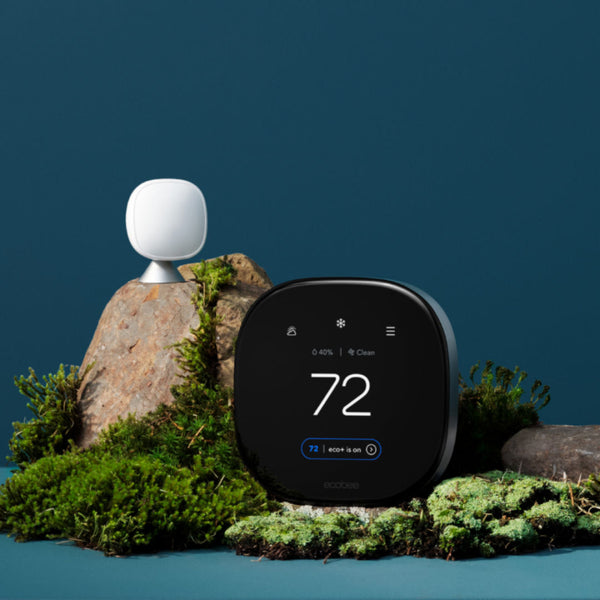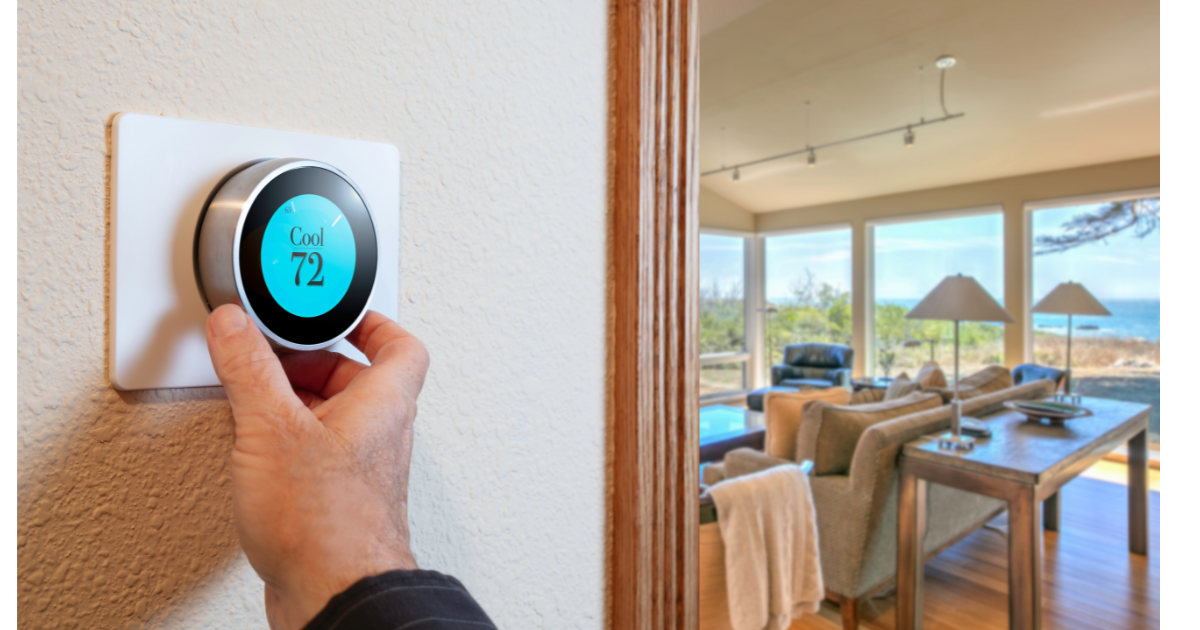Smart thermostats are an innovative technology that can help you save money on your energy bills while improving the comfort of your home. These devices are becoming increasingly popular in 2023 as more homeowners seek ways to reduce their energy consumption and lower their carbon footprint.
So, how do these intelligent thermostats work? In this comprehensive guide, we will explore the technology behind these devices, how they can help you save money, and some key features to look for when choosing a programable thermostat for your home.
The Basics of Smart Thermostats
Smart thermostats use advanced technology to learn your temperature preferences and adjust your home heating and cooling. They achieve this through sensors, algorithms, and machine learning.
These thermostats have sensors that detect temperature, humidity, occupancy, and other environmental factors. They use this information to determine when to turn the heating or cooling system on or off.
In addition to sensors, smart thermostats use algorithms and machine learning to understand your temperature preferences.
These smart home devices can be controlled remotely through a mobile app, and some models can even be controlled by voice commands through Alexa and google assistant.
Benefits of Smart Thermostats - Smart Heating and Cooling

The benefits of using a smart thermostat in your home include:
-
Intelligent management of smart heating and cooling systems, increasing energy efficiency and saving money. Smart thermostats learn a household's temperature preferences and daily routines to automatically adjust the heating and cooling settings for optimal comfort while minimizing energy consumption. This adaptive
approach helps reduce utility bills and contributes to a smaller carbon footprint.
- Intuitive interfaces and remote accessibility, allowing users to monitor and control their smart heating and cooling systems from anywhere using a smartphone or tablet. This convenience provides homeowners with peace of mind and the ability to easily adjust their home's temperature even when they're away, preventing energy waste and saving money.
- Compatibility with other smart home devices and integration with voice-controlled assistants like Amazon Alexa, Google Assistant, or Apple's Siri. This seamless integration enables homeowners to create a fully connected, automated home ecosystem that optimizes energy use based on occupancy, weather patterns, and time of day. By maximizing the benefits of smart heating and cooling, smart thermostats contribute to increased energy efficiency and enhance overall comfort and convenience in daily living.
Common problems with Smart Thermostats and how to fix them

Although smart thermostats are designed to provide precise temperature control, a few factors could contribute to inaccurate temperature readings or improper programming, which can lead to temperature imbalances and cause the HVAC system to turn on or off at the wrong time.:
Incorrect Placement: The location of the smart thermostat can significantly impact its ability to sense accurate temperatures. If the thermostat is placed near heat sources, such as direct sunlight, vents, or appliances, it may register a higher temperature than the actual room temperature. Conversely, positioning the thermostat near drafty windows or exterior doors can lower temperature readings. This can cause the HVAC system to respond inappropriately, creating uncomfortable temperature fluctuations.
Calibration Issues: In some cases, smart thermostats may need to be calibrated to ensure accurate temperature readings. Calibration issues can lead to temperature discrepancies and result in the HVAC system turning on or off at undesired times. Although many modern thermostats come pre-calibrated, it is essential to verify the calibration and make adjustments as necessary.
Programming Errors: User errors in programming the thermostat can also contribute to temperature imbalances. Suppose the thermostat is not set up correctly or the schedules are misaligned with the occupants' preferences and routines. In that case, the HVAC system may turn on or off at undesirable times, leading to discomfort and energy waste.
Sensor Malfunctions: Smart thermostats rely on sensors to detect temperature and occupancy. If these sensors are faulty or malfunctioning, the thermostat may not be able to accurately determine the optimal temperature settings, causing the HVAC system to respond incorrectly.
It is crucial to ensure proper thermostat placement, verify calibration, and follow the manufacturer's guidelines for programming and maintenance To minimize its issues. Regularly updating the smart thermostat's software can also help address potential bugs or glitches impacting its performance. However, If you want to take full advantage of your smart thermostat and resolve these issues for good, installing a smart booster fan is the easiest solution.
SmartCocoon Booster Fans/ Smart Vents
Smart Booster Fans offer an innovative solution to the issues associated with smart thermostats. They can easily integrate with both smart and conventional thermostats, utilizing advanced algorithms to detect the HVAC system's cooling, heating, and off states, ensuring optimal comfort and, on average, 30% more saving on your HVAC energy bill.
The "micro zoning" ability of these booster fans allows them to redirect

How to Choose the Right Smart Thermostat
Choosing the best smart thermostat for your home can be a daunting task, as many options are available on the market today. To make the process easier, consider the features that are most important to you. For example, if remote temperature monitoring is a priority, look for a thermostat with reliable sensors and the ability to adjust the temperature from your phone or tablet. If you want voice control, ensure the thermostat is compatible with your preferred virtual assistant, such as Amazon Alexa or Google Assistant.
Another important feature to consider is energy reporting, which can give you insights into your home's energy usage and help you make more informed decisions about reducing waste and saving money on your utility bills.
The best smart thermostats for 2023:
1. Overall, the best smart thermostat of 2023: Ecobee Smart Thermostat Premium
 Pros:
Pros:- Compatible with multiple platforms (Alexa, HomeKit, Google Assistant, SmartThings, IFTTT)
- Enhanced remote sensors
- Sleek design
- Functions as a home security device and smart speaker
- Monitors air quality
- Dual-band Wi-Fi
Cons:
- Larger than Nest Learning Thermostat
- Expensive
- Some features require a subscription
- Built-in speaker not ideal for music playback
The Ecobee Smart Thermostat Premium features a zinc case, a larger touchscreen, and a sleek design comparable to the Nest Learning Thermostat. It now includes an air quality sensor and displays the week's weather forecast. The thermostat's remote sensors make it easy to manage home temperatures and have built-in Alexa compatibility and Siri integration for HomePod users. While the built-in speaker isn't ideal for music, it's a convenient alternative to an Echo Dot in certain rooms.
2. Best Value for Money: The Amazon Smart Thermostat
Pros:

- Affordable
- Compatible with the Alexa app and voice commands
- Energy Star-certified
- Sleek design and easy-to-use touchscreen interface
- Simple installation and programming
Cons:
- Requires compatible Alexa-enabled smart speaker or display
- Not compatible with Google Assistant or Apple HomeKit
- Requires a C-wire or separately purchased C-wire adapter
- Lacks remote temperature sensors
- Works exclusively with Alexa
Amazon Smart Thermostat stands out for its affordability, compatibility with the Alexa app and voice commands, and Energy Star certification, which saves users an average of $50 annually on energy bills. Its touchscreen interface with a sleek design and an optional wall plate offers easy access to basic settings like temperature adjustments and mode switching. However, it is worth noting that the Amazon Thermostat requires a compatible Alexa-enabled smart speaker or display for voice commands. It is not compatible with Google Assistant or Apple HomeKit. Additionally, a C-wire or a separately purchased C-wire adapter is necessary for installation.
3. Exceptional design: The Google Nest Learning Thermostat


Pros:
- Attractive design with a large display
- Compatibility with various smart home systems
- Easy installation
Cons:
- Inability to monitor the temperature in multiple rooms
- Lack of compatibility with Apple HomeKit
This third-generation nest thermostat features a more extensive, sharper display than its predecessor and learns user behavior over time, allowing it to adjust temperatures automatically based on occupancy.
The Nest Learning Thermostat's high-quality brushed stainless steel finish and rotating mechanism contribute to its premium feel. It is available in multiple finishes such as Brass, Polished Steel, Copper, and White, ensuring compatibility with various interior designs. This innovative thermostat combines the best of past and future technologies, making it one of the top Google Home-compatible intelligent thermostats.
Smart thermostats installation
Smart thermostat installation is simple and often needs just a screwdriver and about 30 minutes. Most smart thermostats require a "C" Wire for power; you'll need an adapter kit if you don't have one. Follow the manufacturer's instructions for installation, removing your old thermostat and connecting wires to the new one.
Once installed, program your smart thermostat to fit your routine and preferences, using preset modes like "home," "sleep," and "away." The mobile app allows remote temperature control and energy monitoring. Set lower temperatures when away or sleeping and utilize smart features like occupancy sensors to save energy.
Smart thermostat installation cost
If professional installation is required, smart thermostat installation costs between $100 to $300, depending on factors such as the type of device and location. In some cases, local utility companies or government agencies may offer rebates or incentives to help offset the cost, making this investment more accessible to homeowners.
Although the initial cost may seem steep, the long-term energy savings and enhanced control over home climate can quickly offset the expense, making it a worthwhile consideration for those seeking to improve their home's energy efficiency.
Conclusion
In a nutshell, these smart devices revolutionize home temperature control, boosting energy efficiency, cost savings, and convenience. Don't forget the game-changing smart booster fans that enhance performance and comfort even further. Make the smart choice, and upgrade your home with an advanced thermostat today!
Top Questions on Smart Thermostats:
Get the Answers You Need!
What makes smart thermostats stand out from traditional ones?
Smart thermostats offer advanced features like learning algorithms, remote control, and compatibility with smart home systems, resulting in improved energy efficiency, cost savings, and convenience.
How do smart booster fans enhance my smart thermostat experience?
Smart booster fans address common challenges associated with smart thermostats by redirecting conditioned air, ensuring optimal comfort, and maximizing energy savings through innovative "micro zoning" technology.
What should I look for when choosing the perfect smart thermostat?
Consider key features like remote temperature monitoring, voice control compatibility, energy reporting, and integration with your preferred smart home ecosystem to find the best thermostat.
Is installing a smart thermostat worth the investment?
While initial costs may be high, the long-term energy savings, enhanced climate control, and convenience make smart thermostats a worthwhile investment for a more energy-efficient and comfortable home.


